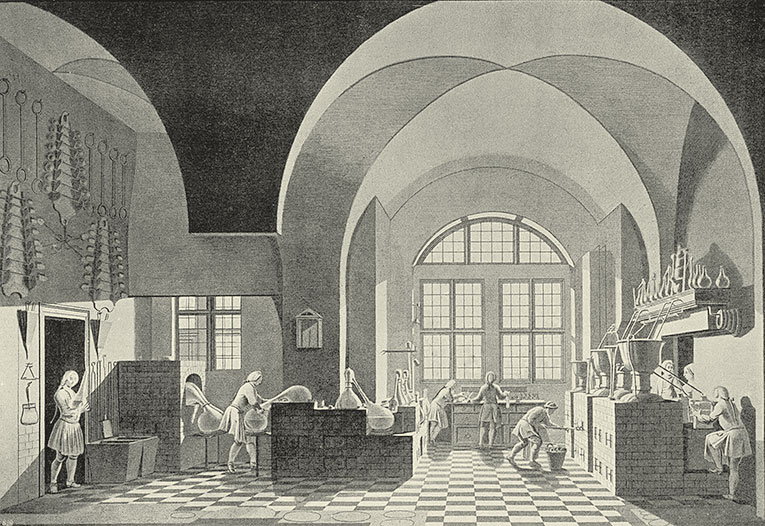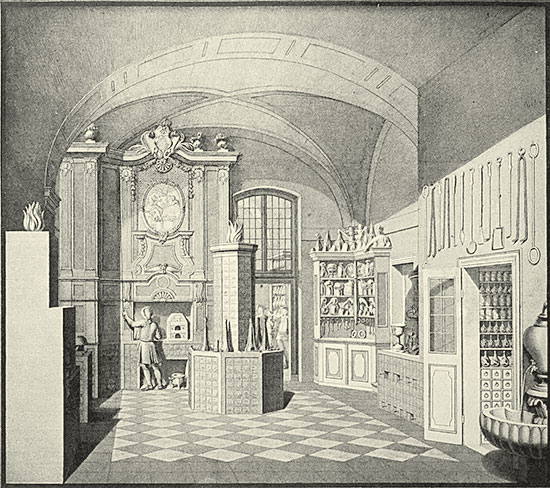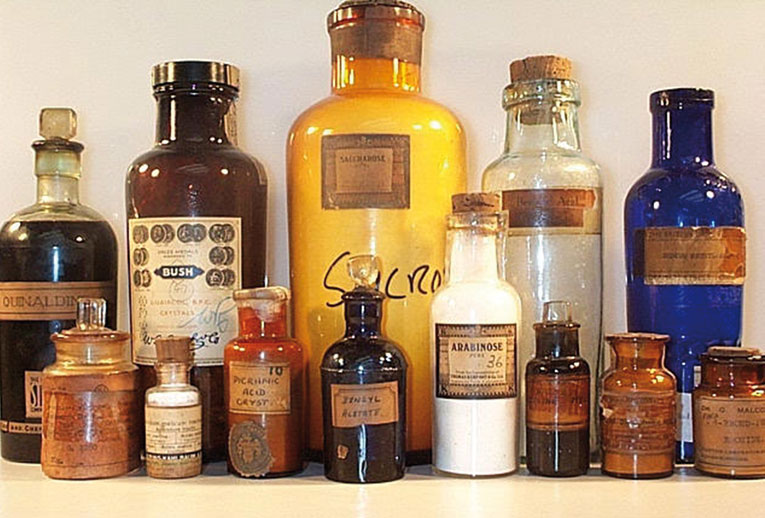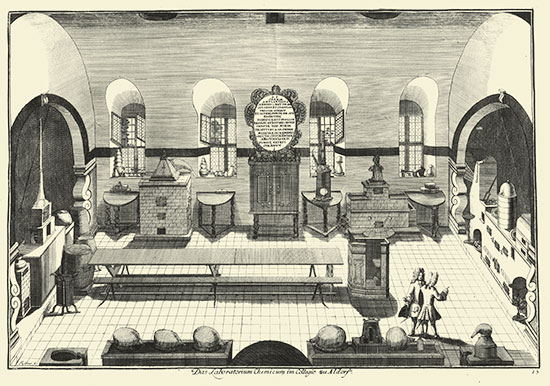 © Mètode The large laboratory of the Royal Court of Berlin. From Johannes Hörmann, 1898. Die königliche Hofapotheke in Berlin (1598-1898), Hohenzollern Jahrbuch 1898. |
||
|
Historians of chemistry have dealt with this science vis à vis physics, taking it as a model for all sciences. In this vein, they often depicted a science concerned with atoms, affinities or Newtonian theories of attractive forces, as well as on the role of principles such as the single hypothetical substance of phlogiston, often forgetting that chemistry is an experimental science devoted to the study of matter and the changes in its state. In recent years, historians of chemistry have begun to wonder which kind of substances have been the object of experiments, past and present. In the following we will see that the substances studied by chemists of the eighteenth century differed greatly from the modern «chemicals» and wonder if the so-called «chemical revolution» engendered a profound or revolutionary change, in the type of substances involved in chemical experiments. In the eighteenth century, chemists studied a rich array of material substances, ranging from entire plants, roots, leaves, flowers, bones, hair, nails and other organized vegetable and animal parts to balsams, resins, gums, oils, fats, and blood extracted from plants and animals, to coal, pitch, petroleum and other raw minerals, to artificial materials such as ceramics, porcelain and glass, as well as processed natural substances such as metals, mineral acids, alkalis and salts. If we include all the kinds of raw material objects and processed substances eighteenth-century chemists studied in their laboratories or described and classified at their writing desks, their number amounts to thousands. From a modern perspective, entire plants, roots and other organs of plants would not be identified as objects of a chemical inquiry. Instead, they are understood as biological objects. In the eighteenth century, however, disciplinary boundaries were different. The exclusion of these «impure» substances from the disciplinary matrix of university-based chemistry was completed around the mid-nineteenth century. Thus, from the whole group of processed substances in the eighteenth century –such as metals, mineral acids, alkalis, and salts– only a small set is immediately recognized as typical «chemical substances». In the eighteenth-century this group of processed «chemicals» had a peculiar status for imposing order on chemistry and for learning and teaching of this discipline. These substances, and only these substances, were ordered in the eighteenth-century tables of chemical affinities as well as in the famous table of chemical nomenclature, published in 1787 by Antoine-Laurent Lavoisier and his collaborators. The Lavoisierian chemical table, which many historians regard as the hallmark of the chemical revolution, enlisted an impressive number of metals, acidifiable bases, alkalis, earths, metal oxides, compounds of metal oxides, compounds of acidifiable bases, gases (compounds of matter and heat) and salts. Was this a revolutionary achievement? Was there really a chemical revolution? It is not possible (for reasons of space) to discuss the Lavoisierian chemical table in all interesting aspects. The gases, which Lavoisier understood as compounds of caloric, were indeed an important group of new substances not represented in tables of affinity. However, with respect to the allegedly revolutionary achievement of the table, two facts are curious: first, the chemical substances presented in the table overlapped to a considerable extent with the material substances presented in the previous tables of chemical affinities. Second the «revolutionary» table also included several types of substances that were excluded from university-based chemistry after the «chemical revolution». These were the alloys and, in an appendix, plant substances such as vegetable oils, resins, tinctures and soaps. Only after the chemical revolution, around 1800, did chemists begin to systematically compare the quantitative composition of a large number of chemical compounds, based on quantitative chemical analyses. The goal of this endeavour, designated stoichiometry, was to unravel regularities or laws of chemical composition. In the new field of stoichiometry, chemists singled out pure chemical compounds in the modern sense, namely stoichmetric compounds with an exact, invariable quantitative composition. In 1813 and 1814, based on stochiometry and John Dalton’s atomic theory, the Swedish chemist Jöns Jacob Berzelius introduced chemical formulas to denote the pure stoichiometric compounds. At this point, alloys, which were still included in the Lavoisierian table of 1787, were no longer defined as proper chemical substances, as they were not stochiometric compounds. Furthermore, in the first decades of the nineteenth century the traditional plant and animal chemistry also underwent a deep transformation, which led to a new type of organic chemistry focusing on stoichiometric carbon compounds and marginalising non-stoichiometric organic substances such as vegetable oils, resins, tinctures and soaps. |
«From the whole group of processed substances in the eighteenth century –such as metals, mineral acids, alkalis, and salts– only a small set is immediately recognized as typical “chemical substances”» |
|
 © Mètode The small pharmaceutical laboratory of the Royal Court of Berlin. From Johannes Hörmann, 1898. Die königliche Hofapotheke in Berlin (1598-1898), Hohenzollern Jahrbuch 1898. |
«The field of material substances regarded as true “chemical substances” underwent a deep transformation» |
|
|
These facts shed new light on the chemical revolution. Why should we regard the Lavoisierian chemistry as a scientific revolution, given the fact that it did not imply a deep change in the kinds of material substances rendered objects of chemical inquiry? It was only several decades after the chemical revolution that the field of material substances regarded as true «chemical substances» underwent a deep transformation. Processed chemical substances in the eighteenth-century The eighteenth-century tables of affinities and the 1787 table of chemical nomenclature selected certain types of processed, chemical substances such as metals, acids, alkalis, earths, salts and metal alloys. All of these substances shared a set of characteristic features. For one thing, they underwent much less complex chemical transformations than the vast majority of materials studied by eighteenth-century chemists. For example, when eighteenth-century chemists distilled plant leaves or animal oils, they decomposed these materials into a large number of different substances, which varied according to the temperature of distillation and other local factors. Eighteenth-century chemists found it difficult to follow this type of chemical change and to draw reliable, general conclusions about the nature of material substances and their reactions. By contrast, metals, acids, earths and alkalis and the salts prepared with them as well as metals and metal alloys underwent comparatively simple chemical reactions, which could be interpreted more easily. For example, when a copper was dissolved in sulphuric acid it was transformed into a salt (copper vitriol), when the solution was evaporated. Moreover, copper vitriol could be decomposed again into copper and sulphuric acid (the latter in a compound form). Likewise, copper and tin combined into the alloy bronze, and bronze could be decomposed in subsequent operations into copper and tin. It was, therefore, substances that were combined in pairs to form new, binary chemical compounds which could in turn break down and be recovered from these compounds in subsequent chemical operations. They thus displayed a stable, reproducible pattern of chemical transformations, namely simple, reversible decompositions and recompositions. In the seventeenth and eighteenth centuries, studies of simple, reversible decompositions and recompositions of salts and alloys enabled chemists to track single substances involved in chemical change and to interpret them as relatively stable chemical building blocks that were preserved in the binary chemical compounds prepared from them. The eighteenth-century tables of affinities grouped together and ordered (according to elective, chemical affinities) such types of substances along with their reversible, binary compositions and decompositions. In so doing they highlighted pure substances, not in the modern sense of nineteenth-century stoichiometry but in the eighteenth-century sense of traceable, single chemical substances, which were not contaminated with other substances. Only decades later, from around 1800, did chemists identify many, but not all, of these processed eighteenth-century chemical substances as stoichiometric compounds. Chemical purity was not the opposite of usefulness Where did these pure, traceable substances come from? In the eighteenth century, the vast majority of them were useful materials. They were products of arts and crafts. Virtually all chemicals represented and ordered in Etienne François Geoffroy’s famous table of chemical affinities (1718) and most chemicals grouped together in the table of chemical nomenclature published by Lavoisier and his collaborators, were useful materials in trade and industry of the time. Trade and commercial production constituted the space in which most of the eighteenth-century chemical substances came into being. Eighteenth-century chemists purchased materials from merchants, apothecaries and other practitioners and reproduced them in their laboratories. They further purified these mundane materials, studied their perceptible properties and analysed their composition. Performing analyses and re-syntheses, in the second half of the eighteenth century, in particular, chemists also introduced new kinds of substances and new experimental techniques that went beyond the existing artisanal materials, instruments, and operations and the different «kinds of air» or gases are a case in point. |
||
 © Courtesy of the University Collection, University of Leeds Chemical substances from the Chemistry Museum at Leeds, founded in 1874. |
«Trade and commercial production constituted the space in which most of the eighteenth-century chemical substances came into being» | |
|
The notion of chemical purity is often regarded as the opposite of usefulness. But careful historical analysis demonstrates that this understanding is historically mistaken. The substances represented in the 18th century tables of affinities and the 1787 table of chemical nomenclature were pure, traceable substances, but the vast majority of them were also useful materials. Late seventeenth-century and early eighteenth-century chemists’ recognition of reversible decompositions and recompositions of these substances was the result of cognitive work, which involved abstraction from the origin and uses of these substances. Abstract reasoning and modelling was no less part of E. F. Geoffroy’s table of chemical affinities from 1718 than it was part of Lavoisier’s table of chemical nomenclature from 1787. All conceptual reasoning and modelling goes hand in hand to a greater or lesser degree with abstractions. But the fact that eighteenth-century chemists constructed abstract building-block models of chemical substances and reactions as well as tables that abstracted from the technological and experimental context of chemical substances does not mean that chemists always and only approached material substances in an abstract fashion. As a matter of fact, eighteenth-century chemists studied material substances from many different perspectives, including their perceptible and imperceptible dimensions, their origins and their uses. Their pure, traceable substances, represented in tables, were only a small part of a much larger world of materials, including raw minerals and plant and animal substances, almost all of which also had a social life as commodities. Social and technological aspects The vast majority of the chemical substances represented in the eighteenth-century chemical tables were not the products of scientific creativity and of a «thriving investigative activity» of chemists experimenting in academic institutions such as the Royal Academy of Sciences of Paris. The eighteenth-century chemists’ pure substances were rather part of a material culture that was shared by university-educated chemists, apothecaries, assayers, mining officials and other experts whose technical work and technological inquiries involved chemical operations. The history of the eighteenth-century concept of chemical purity was deeply embedded in technology and society. The great attention that university-educated chemists paid to reversible chemical reactions and tables of affinities from the mid-eighteenth century eventually contributed to the formation of the concept of stoichiometric purity around 1800. Technology is an important context for this concept, despite the fact that stoichiometry, like the chemical tables of the eighteenth century, abstracted from the origin and uses of substances. The study of pure substances had roots in workshops and artisanal laboratories and was not a pure scientific enterprise. This kind of entanglement of knowing and doing did not change significantly at the end of the eighteenth century in the so-called chemical revolution. Moreover, the so-called chemical revolution promoted neither deep changes in the chemical laboratory and styles of chemical experimentation nor in the kinds of material substances studied by chemists. The chemical revolution was mainly a revision of a bundle of chemical theories and, as a consequence, a reversal of the classes of compound and simple substances; what was simple before was regarded compound later, and vice versa. Apart from theoretical and taxonomic transformations, everything else involved in the chemical revolution was a completion of endeavours that had begun long before Lavoisier entered the stage of chemistry. Lavoisier was more radical than his predecessors and contemporaries in separating chemistry from its alchemical past and from what he considered to belong to metaphysics. However, historians and philosophers of science would probably never have designated his achievements a «scientific revolution» if he and his collaborators had not boldly made this proclamation. As new historical analysis has shown, there was no chemical revolution in the eighteenth century. Chemical laboratories The most important site of eighteenth-century chemists’ natural and technological inquires was the laboratory. Most eighteenth-century experimental philosophers and naturalists performed their experimental trials in any suitable multi-purpose room. By contrast, an eighteenth-century experimenter would have hardly been acknowledged as a «chemist» if it were doubted that he actually had access to a laboratory. The chemists needed laboratories for several reasons. Eighteenth-century chemical techniques required many different kinds of large furnaces along with chimneys as well as water fountains and tons of wood or charcoal, which could not be moved around easily. It was convenient, if not necessary, to have a special room for this equipment. Chemical operations also meant dirty handiwork yielding lots of smelly, corrosive, or poisonous products, which had to be kept apart from studies and ordinary life in the household. Furthermore, most chemical experiments combined different techniques requiring many different types of vessels, instruments, reagents and auxiliary materials, depending on the kind of substance subjected to experimentation and the experimental goals. These vessels required storage space. Chemists’ reagents and samples of substances, stored in phials and jars, also had to be ordered on shelves or in closets and further be protected from humidity and corrosion. In addition, eighteenth-century chemists had established a continual, more or less daily style of experimentation, instead of the often-interrupted experimental trials and public demonstrations of experiments in the core area of experimental philosophy. This style of continual experimentation was rooted in a long historical tradition. It fitted the technological goals inherent in this tradition, as well as the predominant intellectual interests, questions and objects of inquiry of the eighteenth-century chemists: namely, the study of the multifarious world of material substances. In their experimental histories and chemical analyses the eighteenth-century chemists would study one material substance after the other. This style of experimentation was in principle unbounded, not only because of the immense number of substances subjected to experiments but also because of the material productivity of chemical experimentation, which continually yielded new material reaction products. |
||
 © Courtesy of the Niedersächsische Staats-und Universitätsbibliothek Göttingen The laboratory of the University of Altdorf. From Johann G. Puschner, ca. 1720. Amoenitates Altdorfinae oder eigentliche nach dem Leben der gezeichnete Prospecten löblichen Universidad de Altdorf. Michaelis. Nuremberg. |
«An eighteenth-century experimenter would have hardly been acknowledged as a “chemist” if it were doubted that he actually had access to a laboratory» | |
|
Our overall picture of eighteenth-century experimentation has been significantly shaped by historians of physics and their emphasis on the emergence of experimental philosophy in the seventeenth century and of quantification and precision measurement in the Enlightenment. This picture accords with our knowledge of the laboratories and precision experiments of the most famous eighteenth-century chemist, Antoine-Laurent Lavoisier, and of some other prominent chemical philosophers such as Henry Cavendish. Yet their laboratories were not typical. Our concern with these outstanding chemists has too often blinded us to the circumstances of the more ordinary, lesser-known eighteenth-century chemists who contributed to chemistry by repeating artisanal operations and performing experiments with quite mundane instruments such as retorts, beakers, phials and crucibles. We ought not to forget that Lavoisier was a wealthy financier of the Ancien Régime who could afford to purchase outstanding, expensive precision instruments from the most renowned instrument makers of Paris, and that many chemists, who lacked the means to buy such instruments, complained that they were unable to repeat his experiments. In the eighteenth century, laboratories were established at universities and academies as well as in the newly founded professional and technical schools. But at that time, chemical laboratories also existed in apothecaries’ shops, mining administrations, metallurgical plants, mints, arsenals, dyeing manufactories, porcelain manufactories, chemical factories, distilleries and perfumeries. There was a particularly strong similarity between pharmaceutical and academic laboratories. This can be easily seen when we compare drawings and instruments exhibited in today’s pharmacy and science museums. The same types of furnaces, retorts, alembics, jars, beakers, phials, crucibles, and balances that chemists used in academic laboratories were also used by apothecaries for the preparation of chemical remedies. Laboratories of eighteenth-century apothecaries and chemists were often established on the ground floor of a building and in rooms with vaulted stone ceilings. The former was particularly convenient for water and fuel supply; the latter meant protection against fire. Windows were very important for fresh air and to carry off poisonous vapours. The predominant equipment of both chemical and pharmaceutical laboratories included large furnaces, a chimney, and various kinds of distillation apparatus. The shared material culture of the pharmaceutical and academic-chemical laboratory helps explain why apothecaries frequently shifted from the commercial production of chemical remedies to careful observation and chemical analysis and why chemists moved between experimental analysis and pharmaceutical innovation. It explains why many eighteenth-century chemists were apprenticed apothecaries. Observations and experiments performed in pharmaceutical and other artisanal laboratories contributed to chemistry well into the nineteenth century. |
||
BIBLIOGRAPHY
Holmes, F. L., 1989. Eighteenth-Century Chemistry as an Investigative Enterprise. University of California at Berkeley. Berkeley.
Klein, U. & W. Lefèvre, 2007. Materials in Eighteenth-Century Science: A Historical Ontology. MIT Press. Cambridge.





